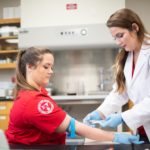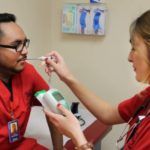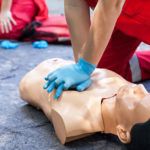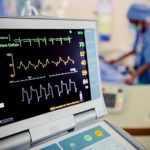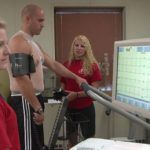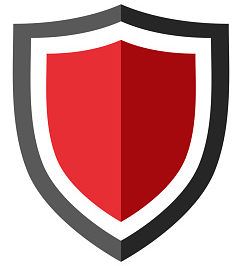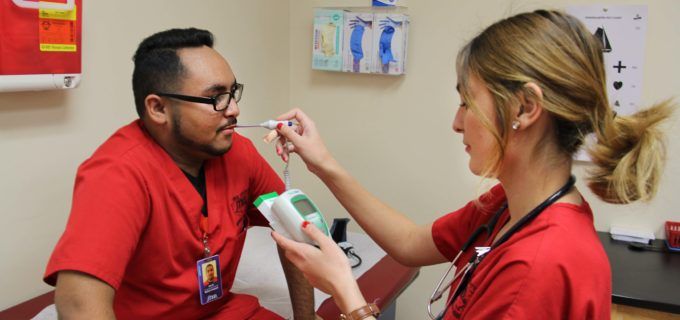Becoming a Medical Assistant
A certified medical assistant (CMA) is the second in command of a hospital or healthcare institution. Their duties revolve around helping the main medical practitioner and aiding patients through procedures. The CMA professional makes sure that the clinic runs smoothly and gives way to the doctor in taking care of their patients.
More on what is a medical assistant.
Education Requirements
A high school diploma or GED is mandatory in order to become a medical assistant. Being a high school graduate or having a General Educational Development (GED) diploma is the minimum required education level to enter the workforce as a medical assistant. For prospects who never went or finished school, the GED training programs are the fastest way of achieving the minimum education level required to become a medical assistant.
Examination costs differ for each state and territory, ranging from tens to hundreds of dollars, depending on subsidies and taxation plans. Here are a few examples:
- Iowa: The GED programs have been substituted by the HiSET (High-School Equivalency Test);
- Tennessee: The GED programs have been substituted by the HiSET (High-School Equivalency Test);
- Colorado: the cost per subject is $37.50 for a total price of $150;
- Minnesota: the cost per subject is $30 for a total price of $120;
- Maine: The GED programs have been substituted by the HiSET (High-School Equivalency Test);
- Connecticut: the cost per subject is $0 for a total price of $0;
- Maryland: the cost per subject is $11.25 for a total price of $45;
- Arkansas: the cost per subject is $4 for a total price of $16;
- Missouri: The GED programs have been substituted by the HiSET (High-School Equivalency Test);
- Montana: The GED programs have been substituted by the HiSET (High-School Equivalency Test);
- Michigan: the cost per subject is $37.50 for a total price of $150;
- Wisconsin: the cost per subject is $33.75 for a total price of $135;
- Illinois: the cost per subject is $30 for a total price of $120;
- California: the cost per subject is $35 for a total price of $140;
- North Dakota: the cost per subject is $30 for a total price of $120;
- New York: The GED programs have been substituted by the TASC (Test Assessing Secondary Completion);
- North Carolina: the cost per subject is $20 for a total price of $80;
- Rhode Island: the cost per subject is $30 for a total price of $120;
- New Mexico: the cost per subject is $20 for a total price of $80;
- Kansas: the price per subject is $33 for a total cost of $132;
- Florida: the price per subject is $32 for a total cost of $128;
- Alaska: the price per subject is $30 for a total cost of $120.
Check other fees and policies for each zip code. More information can be found on official governmental resources.
How to become a medical assistant: passing the GED exam
The candidate must be at least 16 years old, have a valid Identification Card (ID), and make an appointment to an approved testing site. The examination cannot be taken online, and the individual must present themselves to the exam room with their ID card and other personal information previously given to the testing institution.
The GED exam is composed of four separate sections. Successful candidates must pass all four:
1. Reasoning Through Language Arts:
The first part of the test lasts 2.5 hours. Several never-before-seen texts are given to evaluate the student’s reading and writing capabilities. The fragments are both fictional and non-fictional and require editing, paraphrasing, checking grammar, and similar on-text tasks.
More info about the programs can be found through the GED Reasoning Through Language Arts page.
2. Mathematical Reasoning:
The second part of the test lasts 115 minutes. Algebraic and quantitative mathematical queries are provided in four subsegments. An on-screen calculator is allowed for the majority of the problems.
More info about the programs can be found through the GED Math: Quantitative, Arithmetic & Algebraic Problem Solving page.
3. Social Studies:
The third part of the examination comprises five subsections in a total of 70 minutes. Half of the time is dedicated to government sciences (25%) and civic education (25%), while the rest is divided between U.S. history (20%), world knowledge (10%), geography (10%), and economics (10%).
More info about the programs can be found through the GED Social Studies: Civics & Government, U.S. History, Economics, Geography & the World page.
4. Science:
The fourth and last section lasts 1.5 hours. Apart from two open-response topics, the rest of the queries are cross-checking questions. The section is divided among physics (40%) and lifeforms (40%), and the last part between the Universe (10%), and planet Earth (10%).
More info about the programs can be found through the GED Science: Life, Physical and Chemical page.
Other high school diploma equivalency programs:
- HiSET (High-School Equivalency Test);
- TASC (Test Assessing Secondary Completion);
- CHSPE (California High-School Proficiency Exam);
- HSED (High-School Equivalency Diploma or HEP);
- Adult high-school.
Entry-Level Training & On The Job Training
The United States defines the medical assistant as an “unlicensed assistant person.” Unlike phlebotomist, for example, basic medical assistants don’t perform invasive or specialized procedures. Because of this reason, a medical assistant can legally enter the workforce with just a high school diploma or GED and on-the-job training. Although becoming a medical assistant with just on-the-job training is the shortest and most effective method, it’s not usually possible. Finding a medical practitioner willing to train an individual from scratch might prove extremely difficult. The medical industry has developed a de facto requirement for trained prospects. This is mostly due to the litigious reality of the U.S. healthcare system. Most doctors and clinics just aren’t willing to take the risk. However, if a candidate manages to secure such a medical assisting opportunity, they will potentially benefit from immediate training, paid work, and the possibility of obtaining faster certification from the acquired experience.
Several institutions offer basic medical assistant courses. It’s important to research said organizations and review their standards and universality thoroughly. The best medical assisting programs are the ones accredited by the Commission on Accreditation of Allied Health Education Programs (CAAHEP) or the Accrediting Bureau of Health Education Schools (ABHES). Community colleges, universities, vocation, and technical schools offer medical assisting programs. Most plans require around a year to complete.
The same institutions might offer the possibility of acquiring an associate’s degree or a master’s degree. Although these diplomas require at least two years to obtain, they’ll most likely result in a better job outlook and employment opportunities. The higher the education, the higher the chances of surpassing the $33,610 ($16.16 per hour) annual salary. Which, according to the U.S. Bureau of Labor Statistics, is the average wage for a certified medical assistant.
Apart from different eligibility requirements, tuition costs, program variation, program duration, clinical experience, and job placement rates, educational institutions have varying medical assistant course typology:
Classroom programs
The majority of institutions offer on-campus education comprising of face-to-face instruction, laboratory training, and result in a traditional certificate or diploma. Such programs are usually highly acknowledged in the medical industry, but lack schedule flexibility, require physical commuting and doesn’t accommodate work or personal necessities.
Online training programs
Exclusive online medical programs have great schedule flexibility by allowing the student to learn from home and make his own hours. It’s an excellent option for working individuals or people with particular individual needs. However, due to the lack of hands-on medical assistant training and interpersonal interaction with teachers, online courses have less industry acknowledgment and result in less practical experience. Plus, the individual will still have to schedule and externship date and possibly meet other on-site obligations.
Hybrid programs
Cross or hybrid medical programs are a combination of on-campus and online classes. They allow the student to complete a part of their training on-site and the rest of the classes online. It’s a compromise between flexibility and practicality. Some of the schools offering such programs are no less respected than traditional classroom programs. More so, hybrid schools are more time-efficient, reduce commuting expenses, and have many online resources.
Some fundamental skills involved in basic medical assistant training:
- Human anatomy, biology, and pathology;
- Medical terminology and vocabulary;
- Laboratory standards and techniques;
- Clinical diagnostic methods;
- General administrative tasks;
- First aid and checking vital signs;
- Scheduling appointments and bookkeeping;
- Working with patients and kids;
- Pharmacology and prescription refills;
- Patient medical records and history listing;
- Insurance forms and medical billing processing;
- Medical law and work ethics;
- Compliance with Health Insurance Portability and Accountability Act (HIPAA).
How to become a Certified Medical Assistant
After completing one year of basic medical assistant training or two years for a more valuable associate’s degree, it’s highly advised that the medical assistant gets certified. According to the U.S. Bureau of Labor Statistics, a certified medical assistant has an increased median annual salary, better job security, and legal permission to advertise themselves as a “CMA,” “Certified medical assistant,” and similar denominations. It’s paramount to keep in mind that an uncertified medical assistant is vulnerable to legal actions and may not promote themselves under certain industry-specific acronyms. Furthermore, private insurance companies or even governmental insurances such as Medicare & Medicaid won’t support uncertified medical assistants.
There are multiple medical assistant organizations and boarding institutions offering certification. However, the best credentials are obtained through ABHES or CAAHEP approved associations:
- Certified Medical Assistant or CMA from the American Association of Medical Assistants (AAMA);
- Certified Clinical Medical Assistant or CCMA from the National Healthcareer Association (NHA);
- Certified Medical Administrative Assistant or CMAA from the National Healthcareer Association (NHA);
- National Certified Medical Assistant or NCMA from the National Center for Competency Testing (NCCT);
- Registered Medical Assistant or RMA from the American Medical Technologists (AMT);
- Clinical Medical Assistant Certification, Phlebotomy Technician Certification, and Electrocardiograph Technician Certification or CMAC/PTC/ETC from the American Medical Certification Association (AMCA).
More specifics of the most renowned medical assistant certification agencies.
Having completed an associate’s degree or a master’s degree will greatly facilitate obtaining certification through previously mentioned organizations. Having demonstrable clinical experience or extra credits from a higher degree level can shorten the time and resources needed to obtain final certification.
Become a multilateral medical professional
Having multiple certifications is beneficial in furthering one’s medical career and acquiring new knowledge and skills. For example, having a Cardiopulmonary Resuscitation (CPR) certification from the American Red Cross allows the medical assistant to work in emergency situations and become a master at resuscitation, vital signs monitoring, and medical terminology. A Billing and Coding Specialist (CBCS) certification from the National Healthcareer Association (NHA) is a perfect medical assisting training program for medical assistants wanting to focus on medical office clinical duties such as handling computer applications, electronic health records, patient information, and other administrative and bureaucratic paperwork. Another valid alternative would be the Electronic Health Record Specialist (CEHRS) certification also from the National Healthcareer Association (NHA).
Maintaining Your Medical Assisting Certification
Maintaining legitimacy in the medical field means having up to date certifications through periodic re-certification. Most, if not all, agencies require re-certification once every year or two. The process involves a fee of around $100, continuing education to keep up with new medical advancements, and some require re-examination in an approved testing site.
It’s best to thoroughly investigate the re-certification process before registering for that particular agency, as their policy will influence the medical assistant’s career path. The medical assistant has to think ahead of time and visualize the feasibility of the re-certification process.
Re-certification policies differ from one organization to another. Some agencies have a simple online re-certification process, while the more acclaimed boarding institutions require taking a written test in one of their approved schools. However, re-certification exams are rarely final. Meaning that if the medical assistant fails the test, he’ll be allowed to retake it.
Find Employment
According to the U.S. Labor Bureau of Labor Statistics, medical assistant job growth is set to increase by 23% in the next decade until 2028. Although the median salary fluctuates based on the particular U.S. region, the outlook for the medical assistant profession is one of the most prosperous of all industries. More on the salary shifts between U.S. regions.
With an increasingly older population, high global birth rates, and re-surging of global health emergencies such as pandemics, certified medical assistants are needed more than ever.
Job market research
First of all, conduct complete job-research from local newspapers, job-placement agencies, and the internet. Certification agencies usually have employment programs or medical assisting externships available for graduates. If traveling isn’t an issue, local human resources companies will search for jobs in the most needed areas where fast employment is almost certain. Compile a long list of potential workplaces from hospitals, laboratories, blood donation centers, private clinics, ambulatories, imaging centers, outpatient clinics, and other relevant healthcare institutions.
After completing the research, call the desired firms and inquire in detail about the job posts, requirements, accepted certifications, and kindly ask for additional tips and information about the job. Shorten the list based on your eligibility and get ready for the interview.
Preparing your Curriculum Vitae or resume
For medical purposes, a Curriculum Vitae (CV) is a better alternative because of the scientific nature of the job. Also, it’s advised you schedule an appointment and present yourself in person. Sending shorter resumes via mail or fax has a lower chance of success. The basic difference between a Curriculum Vitae (CV) and a resume is that a resume is shorter and contains a small image of your face. Resumes are good for impersonal job applications, but as in most cases, being there in person will add that essential first impression element.
An adequate CV contains all your data, alongside your education, experience, and capabilities. Make sure to include error-free, aerated, and concise personal information and a cover letter. Use a single writing font and be consistent with the formatting. Attach every diploma, certification, associate’s degree, master’s degree, doctorate certificate, and other pertinent training. Furthermore, include specific healthcare experience demonstrated in training, through certifications, retributive work, voluntary work, stages, and internships. Accurately describe your skills and knowledge and customize it in order to fit the necessities of your desired workplace. Avoid unnecessary information such as religious and political beliefs or irrelevant experiences.
Additionally, it’s a good idea to separately keep references from teachers and past employers, blood work, and background checks. Don’t include them in the CV, but keep them handy and present them upon request.
Getting ready for the interview
As for most interviews, the first impression is the key to success. Try to arrive 5-10 minutes in advance, dress professionally, and keep a clean and curated look. Anticipate your employer’s needs and bring all the documentation and extra CV copies. Greet the interviewer with a smile, maintain eye contact, and give a firm handshake. Avoid talking over the interviewer and using strange hand gesticulations.
Try to predict your interviewer’s questions and practice your speech at home. Some typical questions include:
Q: What training do you have, and why do you want to work as a medical assistant?
A: The candidate should describe his education and training, and briefly describe his personality and career ambitions.
Q: What experience do you have in the medical assisting field?
A: This is an excellent opportunity to showcase experiences and particularly tricky medical situations you’ve been a part of.
Q: What are your strengths and weaknesses?
A: The candidate should always focus on his strengths. When talking about weaknesses, the prospect should be sincere but never appear deficient in the fundamental qualities of a medical assistant such as not being able to handle stress, older people, computers, or other potential deal-breakers.
Q: Are you familiar with the HIPAA guidelines? How will you ensure they’re being satisfied?
A: Study the HIPAA guidelines beforehand and explain some basic principles used in real-life situations, such as calling patients only by their first names, keeping private discussions secret, and personal information secured and out of sight.
